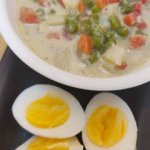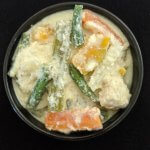Techniques – #L for Layering





Layering is an art form all by itself. We arrange ingredients in a very precise manner based on how they cook. We need to completely visualise the cooking process in our heads before we can start layering. In traditional cooking, layering is not given much importance as you can constantly supervise cooking and can make changes at any point. Think of traditional cooking as painting. The artist is in full control from start to finish. Any errors made can be easily fixed.
Layering is like setting up dominoes. Once you set it up, you have little control over how they behave. If you can visualise the whole process in your head, magic happens on its own. OPOS is science – but layering elevates it to an artform. OPOStars spend an enormous amount of time in learning to rewrite traditional recipes with the right layering format. The rewriting is a prediction of what will happen. Then they try cooking them, to see how the prediction matches reality. Repeated trials and testing are needed before one can start visualising recipes in their head. This is one reason why newbies are banned from trying out their own recipes till they have completed the basic lessons.
Layering was initially introduced when many members faced burning while cooking no water recipes. All recipes were then re standardised to use a thin layer of buffer as the bottom layer. The next layer suggested was a watery ingredient like onion/ tomato/ other watery vegetables/ meats. Easy to burn ingredients like starches, dals, coconut, dry spice powders are never used as the bottom layer.
Apart from preventing burning, the layering technique made a lot of other stuff possible :
Controlled caramelisation
Bypassing cooking inhibitors
Enabling modular cooking
Enabling complex flavour creation
Layering Tips:
1. Always start with a layer of water/ oil as the bottom layer
2. Never add more than 1/4C liquid as layer 1
3. Sprinkle dry spice powders/ coconut over the vegetables/ meats. Never let them touch the bottom
4. Do not mix the layers before cooking.
5. Starches like rice/ pasta need to be completely sandwiched between watery layers (Vegetables/ meats). Else the exposed top layer will not cook.
6. Oils/ fats with higher smoke points promote burning.
7. Onions are notorious for burning. The thinner they are cut, the faster they burn. If they are pressed down ( by other ingredients layered over them), they burn fast. A cooking time of over 5 minutes guarantees burning when onions are used as a bottom layer. Learn controlled caramelisation before using onions as buffer.
